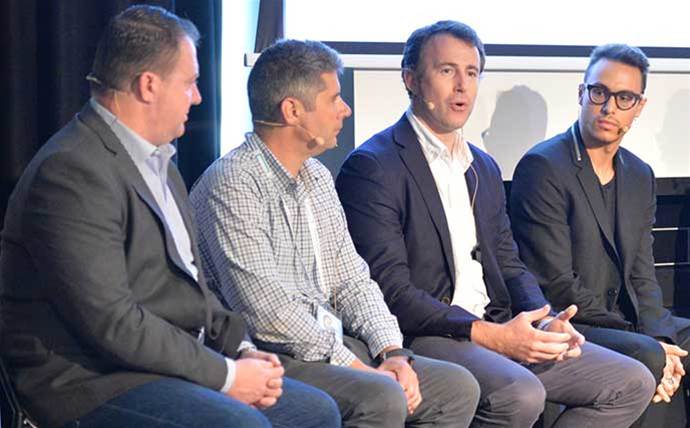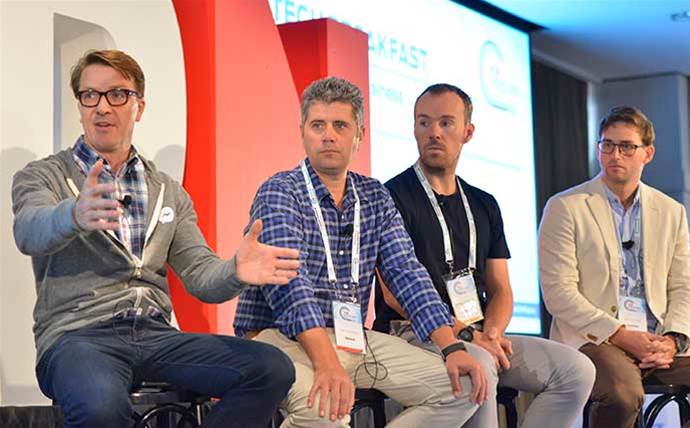Digital business services dominate our professional lives and make up some of the fundamental functions of workplaces, be it in accounting and finance, communication, collaboration, sales or business development.
So, how do the operators of these services engage with their customers on a personal level and offer an experience that drives retention and further engagement? Pipeline audiences were given some insight into these topics when representatives from several of today’s leading online businesses took to the stage.
Jason Juma-Ross, Facebook
To interact well with your customers, you must have smooth workflow and interaction within your organisation and a structure that is people-based.
We had an internal version of Facebook Workplace, and when partners heard about it, we started to roll it out. Using Facebook for our internal collaboration cut a lot of friction points. When I joined, my email count dropped from 200 a day to 20.
A Sydney incubator is using it to manage the flow of ideas across their startups. If you’re a communications company, you must eat your own dog food.
Sam Hunt, GitHub
We see a blurred line from what source code is and who needs it to collaborate more often in the business. We use GitHub to manage GitHub and its development, and we use it to share thoughts and ideas.
We do all our legal, product and marketing collaboration on it. That cuts a lot of emails and we have a single source of truth.
The future for customer experiences is frictionless technology; for things to work the way you expect them, as a customer, to work. Giving time back to the customer is an important part of a beautiful experience.
Ryan Bonnici, HubSpot
There’s a lot of confusion between the buyers’ journey, which is sales, and the customers’ journey. You must separate them and think about your business processes – whether it’s attracting customers, converting into leads – and then delighting them.
Customers aren’t attracted to you because you have content; they just want you to solve a problem they have. And [enterprise IT] companies are starting to realise that they need to write software that’s as easy to use as consumer technology. And people more often want to do things touchlessly, without speaking to a sales rep.

Pictured: Charles Woodall (Salesforce), Samuel Hunt (GitHub), Rob Stone (Xero) and Ryan Bonnici (HubSpot).

Pictured: Jason Juma-Ross (Facebook), Samuel Hunt (GitHub), James Gilbert (HubSpot) and Ben Eatwell (LinkedIn)
Charles Woodall, Salesforce
We started as a CRM company and consume so much data ourselves, so we thought, “How can we use that data to be more predictive?” And we came up with Einstein: an embedded AI that sits in the middle of Salesforce providing predictive analytics to sales teams. It’s also used in healthcare.
We’re partnering with IBM’s Watson to learn how to address bigger issues, such as famine in war zones.
Rob Stone, Xero
We’re building software that gives accountants and SMBs back their time. We look at accounting as an emotional behaviour. We ask our 14,000 partners to vote on their pain points, but if you only did that, you would move in every direction.
Some of our best innovations, such as find and recode, no one asked for, but since launching it, we’ve fixed three million mistakes. That’s real innovation, delivering on a pain point no one knew they actually wanted.
Ben Eatwell, LinkedIn
We ask if we enable our customers to connect to opportunity. Whether that’s to be more successful or productive, or drive better cost per lead or acquisition. Our ‘true north’ was [previously] growing members, and now it is member engagement. We knew that we had to be more than a place you go for an online CV. Longform posts or blogs were critical to that.




.png&h=142&w=230&c=1&s=1)







.jpg&w=100&c=1&s=0)
_(8).jpg&w=100&c=1&s=0)










